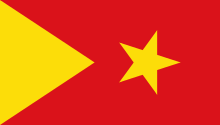Debubawi Zone
Debubawi (Tigrinya: ደቡባዊ) (or "Southern") (formerly also known as Zoba Enderta) is one of the Zones in the Ethiopian Region of Tigray. Debubawi is bordered on the south and west by the Amhara Region, on the north by Debub Misraqawi (Southeastern) Zone, and on the east by the Afar Region. Towns and cities in Debubawi include Maychew, Korem, Alamata. Debub Misraqawi (Southeastern) Zone was separated from Debubawi Zone.
Southern Tigray Debubawi | |
|---|---|
Zone | |
 Flag | |
Southern Tigray location in Ethiopia | |
| Country | Ethiopia |
| Region | Tigray Region |
| Largest city | Maychew |
| Area | |
| • Total | 18,670.45 km2 (7,208.70 sq mi) |
| Population (2012 est.) | |
| • Total | 1,138,440 |
| • Density | 61/km2 (160/sq mi) |
The highest point in this Zone is Mount Tsibet (4090 meters), one of the southernmost peaks of the Raya Mountains. Due to its prominent location dominating the roadway that runs past it from Mek'ele south to Maychew, this mountain has been the scene of several battles. Important bodies of water include Lake Hashenge.
Demographics

Based on the 2007 Census conducted by the Central Statistical Agency of Ethiopia (CSA), this Zone has a total population of 1,006,504, of whom 497,280 are men and 509,224 women; 125,787 or 12.5% are urban inhabitants. Two largest ethnic groups reported in Debubawi were the Tigray (95.36%) and Amhara (2.7%); all other ethnic groups made up 1.94% of the population. Tigrinya is spoken as a first language by 92.49%, Amharic by 5.58% and Xamtanga by 1.01%; the remaining 0.92% spoke all other primary languages reported. 92.15% of the population said they were Orthodox Christians, and 7.79% were Muslim.[2]
Based on figures from the Central Statistical Agency in 2005, this zone has an estimated total population of 1,239,988, of whom 610,164 are men and 629,824 are women; 361,252 or 29.1% of its population are urban dwellers. With an estimated area of 9,310.96 square kilometers, Debubawi has an estimated population density of 133.18 people per square kilometer.[3]
The 1994 national census reported a total population for this Zone of 873,509 people in 210,858 households, of whom 425,655 were men and 447,854 women; 207,352 or 23.7% of its population were urban dwellers. The Zone is predominantly Tigrayan, at 92.1% of the population, while 5.4% were Amhara, 1.5% were Agaw, and all other ethnic groups 1.0%. Tigrinya is spoken by 91.7% of the population, and Amharic was a first language by 6.3% and as a second language by 11.5%. 92.2% of the population said they observed Ethiopian Orthodox Christianity while 7.6% were Muslim.[4]
According to a May 24, 2004 World Bank memorandum, 15% of the inhabitants of Debubawi have access to electricity, this zone has a road density of 80.2 kilometers per 1000 square kilometers, the average rural household has 0.8 hectare of land (compared to the national average of 1.01 hectare of land and a regional average of 0.51)[5] and the equivalent of 0.9 heads of livestock. 34.5% of the population is in non-farm related jobs, compared to the national average of 25% and a regional average of 28%. 64% of all eligible children are enrolled in primary school, and 24% in secondary schools. 36% of the zone is exposed to malaria, and none to Tsetse fly. The memorandum gave this zone a drought risk rating of 627.[6]
Notes
- Geohive: Ethiopia; This figures include Debub Misraqawi Zone
- Census 2007 Tables: Tigray Region Archived November 14, 2010, at the Wayback Machine, Tables 2.1, 3.1, 3.2, 3.4.
- CSA 2005 National Statistics Archived November 23, 2006, at the Wayback Machine, Table B.3
- The 1994 Population and Housing Census of Ethiopia: Tigray Region Archived 2008-12-07 at the Wayback Machine, vol. 1, part 1: Tables 2.1, 2.7, 2.11, 2.14, 2.17
- Comparative national and regional figures comes from the World Bank publication, Klaus Deininger et al. "Tenure Security and Land Related Investment", WP-2991 Archived 2007-03-10 at the Wayback Machine (accessed 23 March 2006).
- World Bank, Four Ethiopias: A Regional Characterization (accessed 23 March 2006).